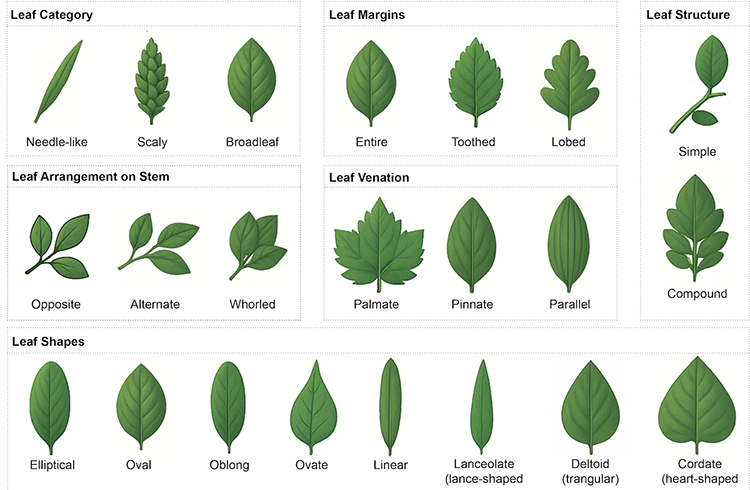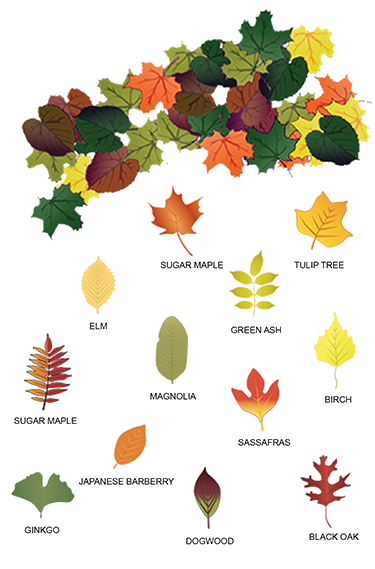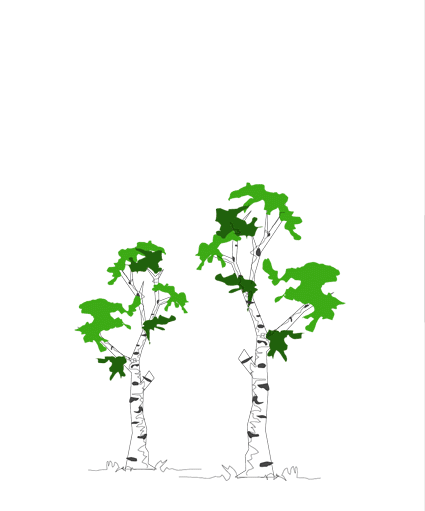
Do you live on a tree-lined street? You probably like trees because you can climb them, sit in the shade, or enjoy the fall color in some climates. Trees help keep streams and rivers clean, provide cool shade and breezes, and improve air and water quality. Trees remove carbon dioxide from the air and produce oxygen through the process of photosynthesis. Trees also house and attract wildlife with their leaves, flowers, seeds, and fruit. Some trees live for hundreds of years and tell us about changing climate and weather. Tree rings are nature’s timeline. Wooded areas keep dirt and harmful chemicals from running into streams as well as reduce runoff and erosion. Some research shows that windows with a view of trees and nature can help reduce stress or even help patients in a hospital heal more quickly.
Trees are our friends.
Activity 1 – Diagram Your Friend the Tree

Draw three diagrams of a tree.
Diagram 1: Start on a fresh page in your journal. Draw a diagram of a tree showing the following parts: roots, trunk, main branches, secondary branches, and leaves. Review this link: thinkquest.org
Diagram 2: After reviewing, record in your journal the following shapes of trees: Columnar, pyramidal, v-shaped, round, oval, weeping. First, draw the natural shape of the tree in pencil, and then draw the geometric figure of the tree in marker. Draw along with this video of tree shapes.
Diagram 3: Draw a cross-section of a tree trunk after reviewing the Life of a Tree. Label the outer bark, inner bark, the cambium, sapwood, and heartwood layers. These terms define the tree layers from the outside to the inside.
bark: outer skin of a tree inner bark: also called phloem, that carries food from leaves to the rest of the tree cambium: growing layer of tree sapwood/xylem: layer that carries water to tree heartwood: center support of tree
Befriend a tree!
Activity 2 – Leaf Indentification

Supplies: Internet, leaves, wax paper, iron, towel, paper and pencil or pen
What trees will grow best where you live? Take a walk and collect some leaves. Using the following website, see if you can identify the kinds of trees in your area: arborday.org. Check to see if your tree is:
Needle or Broad Leaf? Single or Compound leaf? Evergreen or Deciduous tree? Opposite or Alternate?
If you have a smart phone, you can use the free app, LeafSnap. Once you have found and identified 10 leaves, press the leaves between two pieces of wax paper that are the same size. Place one sheet of paper flat on an ironing board, lay the leaf in the middle, and cover with the second sheet. Place a towel over the wax paper and press with a warm iron. If you do not have access to an iron, you can use clear contact paper. Be careful to lay the leaf flat onto the sticky side and then cover the leaf smoothing out bubbles. Label the pressed leaves and put them in a tree identification folder.
Activity 3 – What Are the Benefits of Trees?

Trees enhance the beauty of homes and properties, boost their value, and help save energy costs. Shade trees planted on the east and west sides of a building keep it cooler, reducing the need for air conditioning; they also protect concrete sidewalks and asphalt parking lots. A line of trees called a windbreak helps block cold winter winds. Trees also reduce traffic noise in cities. Ingredients from trees are found in products like toothpaste, shampoo, and shaving cream! Sap from rubber trees is used to make tires. Trees improve air quality and filter 55% of America’s drinking water. Looking at trees helps us relax. Create an outline explaining how trees are our friends. Check out the trees in your school yard at the National Tree Benefit Calculator. [Make your family tree]( and upload it to the gallery
List several ways trees contribute to our daily lives.
Activity 4 – Tree Species

There are close to 10,000 identified species of trees on earth. There are more than 1,000 different species of trees in the United States alone. In the US, there are twice as many hardwood trees as softwood trees. Less than 100 types of trees are commercially used. Tree species group trees together that share the same morphology (form), DNA (genetics), geography (location) and propagation(regeneration). Now that you know the name of the trees in your yard and on your school ground, look at other species of the same tree. For example, if the tree in your yard is a fir tree, you can investigate the Balsam Fir, Fraser Fir and the Noble Fir. If your tree is a maple, look for the Silver Maple and Red Maple and if the tree at your school is an oak tree, find other types of oaks. Select three trees that you know. Make a tree poster with other types of trees that fit your three species. Show the leaves, leaf arrangement, shape of the tree and bark description. Record the scientific names for all of your trees. Scientific names for species use binomial nomenclature. Binomial nomenclature means that there are two names given. The first name is the genus name and the second name the species. The terms are usually Greek or Latin. For example, there are over 400 species of oak trees. The scientific name of the White Oak Tree is Quercus alba, where the genus Quercus is Greek for oak and the species is Latin for white.
Know your species!
Activity 5 – Tree Extremes

What and where are extreme trees? Extreme trees are the largest trees found growing on earth, or the smallest. Investigate extreme sizes. Nominate a tree in the United States as a Champion Tree. To nominate a tree, you need to measure the trunk size, tree height and tree width. All three numbers are added together to get a total. As people nominate trees, a winner that has the highest total wins champion status. The Sequoian National Park has five of the world’s largest trees. Its largest tree is the General Sherman. To look for a champion tree nearby take a walk in the fresh air and seek out a wooded area. Be sure to take your measuring tape, a ruler and a digital camera. Once you find a large tree, measure the circumference of its trunk at 4 ½ feet above the ground. If the tree is on a slope measure the high and low side circumference and average the two. Note this dimension in your journal. To figure the width of the tree, you need to walk from the center of the tree to the furthest extended branch and or leaf. From this point walk toward the trunk to the opposite widest extension. Record this measure. Then take the narrowest tree coverage dimension by repeating this same walk under the tree coverage. Average the two numbers for your tree width. Finally, walk away from the tree until you can fit its complete height (from the point the trunk enters the ground to the highest leaf top branch in the sky). Use a ruler to calculate this dimension. For assistance look at measuring guidelines. As for the smallest trees, look into the art of Bonsai.
Take measure of your trees!
Trunk Circumference (inches) + Height (feet) + ¼ Average Crown Spread (feet) = Total Points
Activity 6 – Tree of Life

A tree is a living plant. It supports all kinds of life. Think of a tree as a ‘home’ for insects, animals, birds, lichen, moss, etc. Look at trees in your neighborhood. What life can you discover? Draw or photograph a tree in your neighborhood and draw all of the livings things you discover on, in, and under the tree! You can even include people if there is a treehouse!!
Activity 7 – Draw Along People & Trees

On a hot day or a rainy day, if you are walking outside, you will find that trees are your friends. They will provide cool shade from the sunshine and keep you mostly dry during a rainfall. Draw Trees with people from the top and from the side in this DRAW ALONG VIDEO.
Activity 8 – Plant a tree
Now that you know more about trees, consider planting one to support the earth and the biodiversity of life that thrives in trees! First, consider what kind of tree you would like to plant, why, and where! Is it an evergreen tree that will stay green year-round and has needles? Is it a fruit tree that will bear cherries or other fruits in the summertime? Is it a shade tree to help shield your house from the summer sun and let the sun’s warmth and light into your home in the wintertime? Consider how tall and wide the tree will grow when it reaches maturity. Then pick a site for the tree you have chosen. Make sure it has enough girth for the tree to mature. Clear the site and check to see if the soil is rich in nutrients. Have someone help you obtain and carry the tree if it is as big as a sapling (3 feet or more). Water the tree’s root ball. Dig a hole one and ½ as deep as the tree root and two to three times as wide as the tree root. Remove the sapling from any root bag that may have been applied for traveling. Place the tree in the hole in the center. Cover the roots with part of the soil you dug, mixed with compost, organic peat moss, and potted plant soil, up to the base of the young tree. Gently compress the soil in the hole. Place three different ropes to keep the tree growing vertically from the trunk to a peg in the ground. Have someone help you balance all three supports so it is not leaning. Water the plant regularly, especially during the first growing season, if it doesn’t rain. Build a fence if you are in a deer area, as they may eat its bark. Talk to your tree daily and let it know that you are thankful to have its shade and clean air!
Activity 9 – Trees during the seasons

Trees are categorized as deciduous and evergreen trees based on coloration and foliage during the seasons. Deciduous trees-maples, oaks, beeches, and birches- share vibrant coloration of their leaves in the fall, which then drop to the ground and decompose to build nutrients in the topsoil; deciduous trees regrow their leaves each spring providing shade in the summer and sunlight on the ground in the winter.Evergreen trees, such as pines, firs, spruce, and cedars, retain their foliage year-round. They offer visual greenery in the landscape year-round, providing wildlife shelter. Flowering trees, like dogwoods and magnolias, are known for their vibrant blooms in the spring. Some trees, like the Flowering Dogwood, display flowers in spring, foliage in summer, colorful leaves in fall, and unique branching and bark in winter. Other examples include the Red Dogwood, which has red flowers in spring, green foliage in summer, reddish-purple leaves in fall, and contrasting bark in winter. Flowering trees add beauty and aesthetic appeal to landscapes, attracting pollinators and providing food sources for wildlife.
Which type of tree are you?
Review

- Photosynthesis is the process of:
- A tree ring represents how many years of growth?
- A tree’s roots extend as far as its branches reach.
- All trees require the same amount of water.
- How many different tree species are there?
Explore
- 52 Types of Wood and the Trees they Come from
- Agnes Denes Tree Mountain in Finland
- All About Trees
- Alliance For Community Trees
- Allometric Coefficients for Common North American Trees
- Anatomy of a Tree
- App LeafSnap!
- ARBOR DAY TREE ID
- Arthur Wiechula Tree Sculpture
- Artist Olivia Robinson's Electronic Quilt
- Bonsai Trees fro Beginners
- Dichotomous Tree Key
- Drawing General Sherman, Sequoia National Forest, Video
- Earthruns Trees reverse Climate Change
- Equitable Access to Trees in Neighborhoods
- Fall Foliage Map US
- From Woods to Wood
- Fruit Trees 101
- Global Forest Watch Maps
- Green School Yard Forest Design Lecture Series(videos)
- Heat Mitigation with Trees providing Shade
- How Forests Mitigate Climate Change
- How to Draw a Tree
- How to identify Trees Around Your Own Home
- How to Plant a Tree
- Identify Trees!
- Leafsnap!
- LEAF Tree Identification Cards
- Life of a Tree
- Magic under your feet!
- Measure a Trees Diameter
- Measure Tree Height
- Measuring Basics
- National Tree Benefit Calculator
- Outdoor Learning The Importance of Trees
- Pete Nelson Treehouses
- Plant a Tree When you use the web Ecosia
- Plant Trees 4 Life
- Schoolyard Forests
- The importance of Urban trees
- The NAture of Trees Arnoldia
- Tree Benefit Calculator
- Tree Circus at Gilroy Gardens
- Tree Classification and Plant Guide Avas Flowers
- Tree identification
- Tree Identification by Fruit
- Tree Identification: By Leaf, Fruit or Name
- Tree Interaction With History
- Trees 4 Life International
- Trees 4 Life Moringa- A Tree of Food
- Trees Ease Inner City Neighborhoods
- Trees, forests and water: Cool insights for a hot world
- Trees in the Townscape (UK)
- Tree Types!
- Underground Mycorrhizal Network of Trees
- Video Introducing Plant for the Planet
- Video Reggio Life in a Forest
- VIDEO: The Most Amazing Things About Trees
- Video Why Does a Leaf Change Color?
- Where are our Forests? (US)
Relate
- Animals
- Biomes
- Biophilic Architecture
- Carbon Cycle
- Cities
- Earth
- Earth Energy Balance
- Family Tree
- Flowers
- Forests
- FUNGI
- Furniture Design
- Grass
- Grasslands
- Green Materials
- Green Neighborhoods
- Green Roofs
- Green Streets
- Greenways
- Habitats
- Landscape
- LAND USE
- Nature Patterns
- Nature Play
- Paper Engineering
- Parks
- Permaculture
- Place Experience
- Place Exploration
- Plants
- Pocket Parks
- Precipitation
- Rain Gardens
- Shape
- Site Programming
- Soil
- Temperature
- Topography
- Tree Identification
- Water Conservation
- Watershed
- Wetlands
- Wood



















































